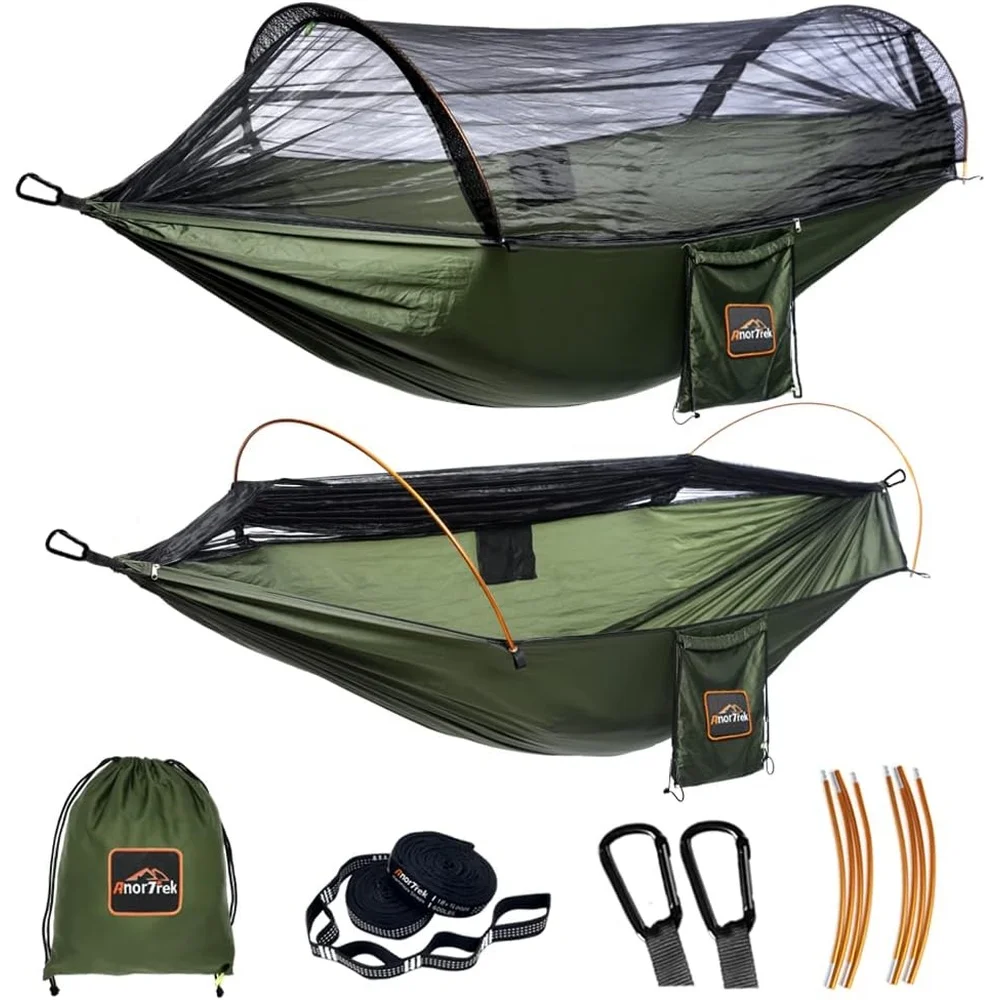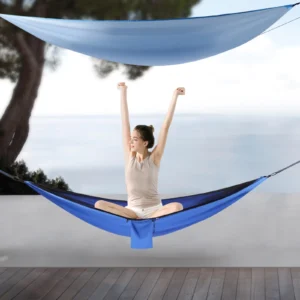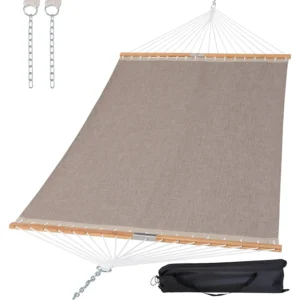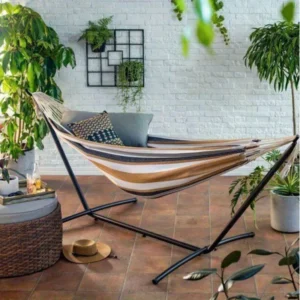Understanding Hammock Weight: Why It Matters for Your Outdoor Experience
When venturing into the great outdoors, every ounce in your pack makes a difference, especially when it comes to your sleeping system. Hammock weight isn’t just a number—it’s a crucial factor that directly impacts your overall experience.
For backpackers trekking miles into the wilderness, a lightweight hammock can save significant energy. Consider this: saving just 2 pounds on a 3-day trip equals roughly 600-800 fewer calories burned—the equivalent of an extra meal! Meanwhile, car campers might prioritize durability and features over minimal weight.
Understanding hammock weight terminology helps make informed decisions:
– Hammock-only weight: Just the fabric body without any accessories
– Complete system weight: Includes everything needed (suspension, rain protection, insulation, bug protection)
Your camping style directly impacts how much weight matters to you:
– Thru-hikers and ultralight backpackers obsess over every ounce
– Weekend warriors can afford slightly heavier systems for added comfort
– Base campers might prioritize durability and features over weight
The concept of “weight-to-comfort ratio” is key—finding that perfect balance between carrying less and sleeping well. Different indoor and outdoor hammock placement scenarios also influence how much weight you’ll want to carry to your destination.
For serious backpackers seeking to minimize their load, exploring ultralight camping hammock sets can significantly reduce pack weight while still providing comfortable shelter.
What Makes Up a Hammock’s Weight: Materials, Construction & Design
Understanding what contributes to a hammock’s weight helps you make smarter choices based on your needs. The primary components affecting weight include:
Fabric Materials
- Nylon varieties: The most common hammock material with varying weights
- 70D (denier) nylon: Durable but heavier at 1.9 oz/yd² (64 g/m²)
- 40D ripstop nylon: Good balance at 1.4 oz/yd² (47 g/m²)
- 20D ripstop nylon: Lightweight at 1.1 oz/yd² (37 g/m²)
- 15D nylon: Ultralight at 0.9 oz/yd² (30 g/m²)
- Polyester vs. nylon: Polyester is often slightly heavier but resists stretching when wet
- Specialty ultralight fabrics:
- Hexon: Proprietary ultralight fabric from 0.8-1.6 oz/yd²
- Monolite: Extremely lightweight at 0.67 oz/yd² (23 g/m²)
- DCF (Dyneema Composite Fabric): Incredibly light but expensive at 0.5-0.8 oz/yd²
Design Factors
- Single vs. double hammocks: Doubles use 30-50% more fabric, adding 4-8 oz (113-227 g)
- Gathered-end vs. bridge hammocks: Bridge designs include spreader bars adding 4-12 oz (113-340 g)
- Dimensions: Each additional inch in width/length adds weight
- Standard single: ~9 ft × 4.5 ft (2.7 m × 1.4 m)
- Wide/double: ~10 ft × 6 ft (3 m × 1.8 m)
Integrated Features
- Built-in bug nets: Add 4-8 oz (113-227 g) but eliminate need for separate gear
- Integrated ridgelines: Add 0.5-2 oz (14-57 g) depending on material
- Reinforcements: Extra fabric at stress points adds durability but increases weight
Understanding proper hammock installation requirements and safety also informs how much weight you’ll need in construction materials for reliable performance.
Suspension Systems: The Often Overlooked Weight Factor
When comparing hammock weights, many campers focus solely on the fabric body while overlooking the suspension system—which can actually outweigh the hammock itself! A complete suspension system includes:
Tree Straps
- Material options:
- Polyester webbing: 2.2 oz per 10 ft (62 g per 3 m)
- Nylon webbing: 2.0 oz per 10 ft (57 g per 3 m)
- UHMWPE/Dyneema: 0.7 oz per 10 ft (20 g per 3 m)
- Width impact: Wider straps (1.5”) protect trees but weigh more than narrower options (0.75”)
- Length considerations: Each additional foot adds weight—standard pairs range from 6-15 ft (1.8-4.6 m) total
Connection Hardware
- Traditional carabiners: 1.5-2 oz (43-57 g) each
- Aluminum toggles: 0.2-0.4 oz (6-11 g) each
- Whoopie slings: 0.5-0.8 oz (14-23 g) per pair
- Cinch buckles: 0.8-1.5 oz (23-43 g) per pair
Weight-to-Strength Comparison
| Suspension Component | Weight | Safe Working Load |
|---|---|---|
| 1” Polyester Webbing | 2.2 oz per 10 ft (62 g per 3 m) | 500 lbs (227 kg) |
| 1” Dyneema Webbing | 0.7 oz per 10 ft (20 g per 3 m) | 1,500 lbs (680 kg) |
| Aluminum Carabiner | 1.7 oz (48 g) | 400 lbs (181 kg) |
| Titanium Toggle | 0.3 oz (8.5 g) | 300 lbs (136 kg) |
By switching from standard polyester straps and carabiners to Dyneema and titanium toggles, you can save nearly 5 oz (142 g)—significant when every ounce counts. Many camping hammock sets with bug nets include suspension systems with varying weights, so comparing complete packages is essential.
Hammock Weight Categories: From Ultralight to Comfort-Focused
Hammocks fall into distinct weight categories, each offering different benefits for specific users and situations:
Ultralight Hammocks (<12 oz / 340g for hammock body)
Pros:
– Minimal pack weight and volume
– Perfect for long-distance hiking
– Often pack down to the size of a softball
Cons:
– Typically less durable (15-30D fabrics)
– Often narrower with less comfort
– Usually higher cost per ounce
Examples: Hummingbird Single, Sea to Summit Ultralight, Outdoor Vitals Ultralight
Lightweight Backpacking Hammocks (12-16 oz / 340-450g)
Pros:
– Good balance of weight and durability
– Often wider than ultralight models
– Better value than ultralight options
Cons:
– Slightly more pack space required
– May use 40D fabric with moderate durability
– Typically lack integrated features
Examples: ENO SingleNest, Grand Trunk Ultralight, Kammok Roo Single
Standard Camping Hammocks (16-32 oz / 450-900g)
Pros:
– Excellent durability with 70D fabrics
– Wider dimensions for comfort
– Often include integrated features
– Better value for occasional users
Cons:
– Noticeably heavier for backpacking
– Larger packed size
– May be overkill for fair-weather use
Examples: ENO DoubleNest, Kammok Roo Double, Hennessy Expedition
Comfort-Focused/Heavy-Duty Hammocks (32+ oz / 900g+)
Pros:
– Maximum durability for years of use
– Extra-wide dimensions
– Higher weight capacity
– Often include multiple features
Cons:
– Too heavy for backpacking
– Large packed size
– Overkill for many users
Examples: Kammok Roo Double XL, ENO SkyLoft, Most Bridge Hammocks
Bridge Hammocks (Special Category)
Bridge hammocks deserve special consideration as they typically weigh 25-45 oz (700-1,275g) due to their spreader bar design, but offer a flatter lay that some campers find more comfortable. Their unique weight profile reflects the trade-off between comfort and portability.
Understanding that weather exposure impacts durability may influence whether it’s okay to leave your hammock outside and what weight category makes sense for your specific usage pattern.
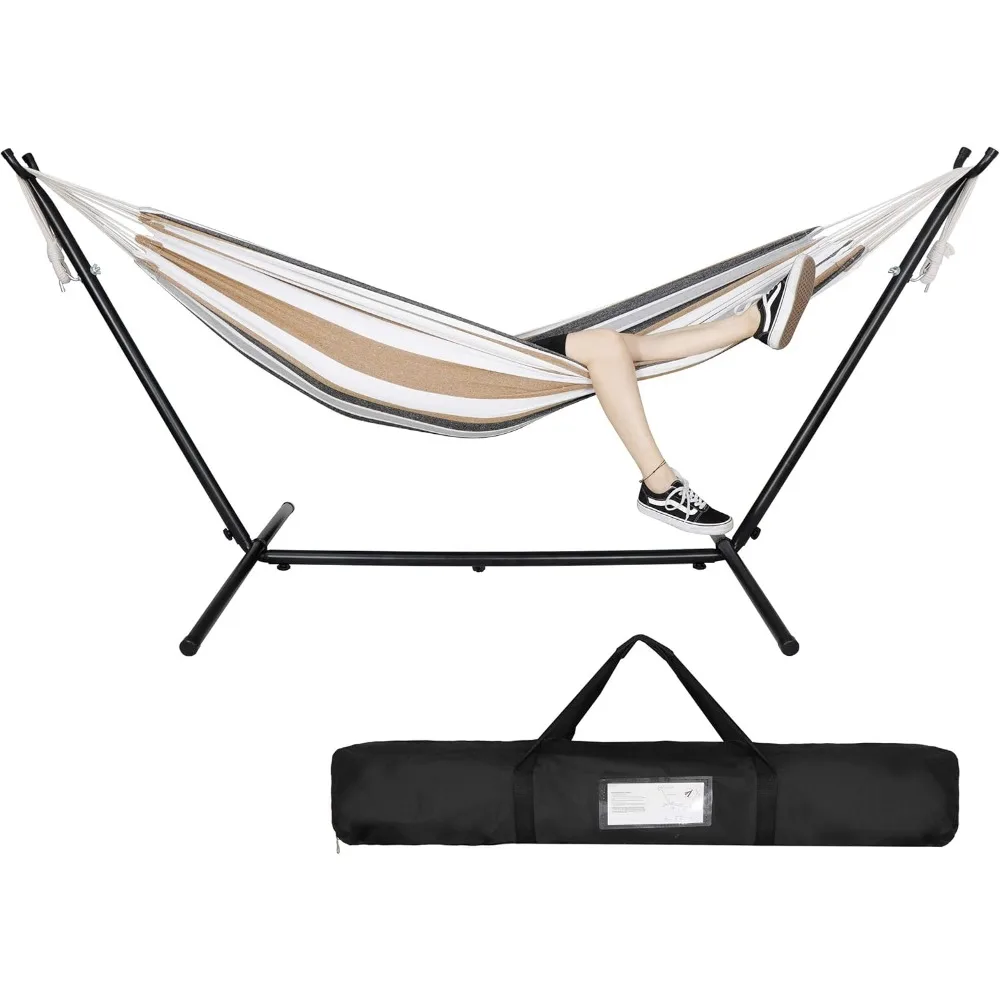
Beyond the Hammock: Essential Accessories and Their Weight Impact
The hammock itself is just one piece of your sleep system. Consider these accessories and their weight contributions:
Rain Protection (Tarps)
- Silnylon tarps: 12-20 oz (340-567 g), excellent value
- Silpoly tarps: 11-18 oz (312-510 g), less stretching when wet
- DCF (Dyneema) tarps: 7-12 oz (198-340 g), ultralight but expensive
- Size impact: Hexagonal (minimal) vs. rectangular (full coverage)
- Hex tarp: ~8×10 ft adds 14 oz (397 g)
- Rectangle tarp: ~10×12 ft adds 20 oz (567 g)
Bug Protection
- Integrated nets: 4-8 oz (113-227 g) added to hammock weight
- Separate bug nets: 6-12 oz (170-340 g)
- Mesh types: No-see-um (lighter) vs. stronger meshes (heavier)
Insulation Systems
- Down underquilts: 12-30 oz (340-850 g), depending on temperature rating
- Summer (50°F/10°C): 12-16 oz (340-454 g)
- 3-Season (30°F/-1°C): 18-22 oz (510-624 g)
- Winter (0-20°F/-18 to -7°C): 24-30 oz (680-850 g)
- Synthetic underquilts: Add 20-40% more weight than down for equivalent warmth
- Topquilts: Similar weight ranges to underquilts
Alternative Insulation
- Closed-cell foam pads: 8-14 oz (227-397 g), less comfortable but reliable
- Inflatable sleeping pads: 12-24 oz (340-680 g), more comfortable but can shift
“Small but Significant” Items
- Stakes: 0.5-1 oz (14-28 g) each, usually need 4-8
- Guylines: 1-2 oz (28-57 g) total
- Storage bags: 0.5-2 oz (14-57 g)
Many campers are surprised to learn their insulation system often weighs 2-3 times more than their hammock! For convenience, exploring complete camping hammock systems with coordinated components can ensure all elements work well together at an optimized weight.
Complete System Weight Scenarios for Different Camping Styles
To understand real-world applications, let’s look at three complete hammock setups optimized for different priorities:
Ultralight Backpacker (<2.5 lbs / 1.1 kg complete system)
| Component | Item | Weight |
|---|---|---|
| Hammock | Ultralight 15D Nylon | 9 oz (255 g) |
| Suspension | Dyneema Straps & Toggles | 3 oz (85 g) |
| Rain Protection | Minimal DCF Hex Tarp | 7 oz (198 g) |
| Bug Protection | Lightweight Head Net | 2 oz (57 g) |
| Insulation | Summer Down Underquilt | 14 oz (397 g) |
| Accessories | Stakes, Guylines, Storage | 5 oz (142 g) |
| TOTAL | 2 lbs 8 oz (1.13 kg) |
Trade-offs: Maximum weight savings at the expense of comfort, durability, and full protection. Best for experienced hammockers in fair conditions.
All-Around Backpacker (2.5-4 lbs / 1.1-1.8 kg complete system)
| Component | Item | Weight |
|---|---|---|
| Hammock | 40D Ripstop Nylon | 16 oz (454 g) |
| Suspension | Polyester Straps & Lightweight Buckles | 7 oz (198 g) |
| Rain Protection | Silpoly Rectangle Tarp | 16 oz (454 g) |
| Bug Protection | Full Bug Net | 8 oz (227 g) |
| Insulation | 3-Season Down Underquilt | 20 oz (567 g) |
| Accessories | Stakes, Guylines, Storage | 8 oz (227 g) |
| TOTAL | 4 lbs 11 oz (2.13 kg) |
Trade-offs: Good balance of weight, protection, and comfort. Versatile for most 3-season conditions.
Comfort-Focused Camper (4+ lbs / 1.8+ kg complete system)
| Component | Item | Weight |
|---|---|---|
| Hammock | Bridge Hammock with Spreader Bars | 32 oz (907 g) |
| Suspension | Wide Polyester Straps & Carabiners | 12 oz (340 g) |
| Rain Protection | Large Silnylon Tarp | 22 oz (624 g) |
| Bug Protection | Integrated Bug Net | (included) |
| Insulation | Deluxe Down Underquilt | 26 oz (737 g) |
| Accessories | Stakes, Guylines, Storage | 12 oz (340 g) |
| TOTAL | 6 lbs 8 oz (2.95 kg) |
Trade-offs: Prioritizes comfort and convenience over weight savings. Better for shorter hikes or base camping.
Understanding how much weight your hammock can hold is also crucial when selecting a system that balances weight savings with structural requirements for your body type.

Making Smart Weight Decisions: When to Save Ounces and When to Carry More
Making intelligent choices about hammock weight depends on understanding your specific needs:
When Weight Savings Matter Most
- Long-distance hiking: On a 100-mile trip, each extra pound feels like three by the end
- Hot weather camping: Minimal insulation needed means potential for ultralight setups
- Mountainous terrain: Steeper climbs amplify the impact of extra weight
- Experienced hammockers: Know exactly what they need (and don’t need)
When Extra Weight May Be Worth It
- Cold weather camping: Never skimp on insulation when temperatures drop
- Frequent heavy rain: Larger tarps provide better protection
- Short hiking distances: If you’re only walking a mile to camp, comfort can trump weight
- Larger body types: Need stronger materials and wider dimensions
- Beginners: May benefit from easier-to-use, more forgiving systems
Smart weight-saving prioritization:
– Focus first on “the big three”: hammock, tarp, and insulation
– Consider the weight-to-cost ratio: Sometimes spending more saves significant weight
– Look at multi-purpose items: Could your trekking poles support your tarp?
– Seasonal adaptations: Pack differently for summer versus shoulder seasons
Many lightweight hammock sets offer an excellent middle ground, providing durability and comfort while still maintaining reasonable pack weight.
Practical Weight-Saving Tips for Your Hammock System
Replace heavy hardware: Swap carabiners (1.7 oz/48g each) for toggles (0.3 oz/8.5g each) to save 2.8 oz (79g) per hammock
Optimize strap length: Calculate your actual needs; carrying 15-foot straps when 10 feet works saves 2 oz (57g)
Consider seasonal removals: Leave the bug net at home in cooler months (6-8 oz/170-227g savings)
Downsize your tarp for fair weather: Using a minimal tarp instead of full coverage saves 6-10 oz (170-283g)
Use multi-purpose gear: Your rain jacket can serve as a top insulation layer in a pinch
Choose temperature-appropriate insulation: Don’t carry a winter underquilt in summer (save 10+ oz/283+g)
Invest in higher-quality materials: 800+ fill power down saves 20-30% weight over 650 fill power
Simplify your suspension system: Streamlined options like spider/web straps weigh less than daisy-chain systems
Pack smartly: Use your hammock stuff sack as a pillow to eliminate a dedicated camping pillow
Consider cottage vendors: Small manufacturers often produce ultralight options not available from major brands
Understanding the best indoor and outdoor hammock locations can also help you pack appropriately for specific environments, eliminating unnecessary weight for your destination.
Camping Hammock Sets with Bug Net, Ultralight Camping Hammock Sets
$139.72 Select options This product has multiple variants. The options may be chosen on the product pageCamping Hammock Sets with Bug Net, Complete Camping Hammock Systems
Price range: $82.73 through $97.96 Select options This product has multiple variants. The options may be chosen on the product pageFolding Hammock Sets, Lightweight Hammock Sets
$295.80 Select options This product has multiple variants. The options may be chosen on the product pageComplete Camping Hammock Systems, Hanging Egg Chair Sets
$266.73 Select options This product has multiple variants. The options may be chosen on the product pageComplete Camping Hammock Systems, Folding Hammock Sets, Lightweight Hammock Sets, Quick Setup Hammock Sets
$255.54 Select options This product has multiple variants. The options may be chosen on the product page
Finding Your Perfect Balance: Questions to Ask Before Choosing a Hammock
Finding your ideal hammock weight requires honest self-assessment. Ask yourself:
What’s my primary use case?
– Backpacking 10+ miles daily requires ruthless weight minimization
– Weekend trips allow more comfort-oriented choices
– Car camping removes most weight constraintsHow far will I typically carry my hammock?
– Under 3 miles: Weight matters less
– 3-10 miles: Balance is crucial
– Over 10 miles: Every ounce countsWhat’s my sleeping style and comfort threshold?
– Side sleepers often need wider hammocks despite weight penalties
– Back sleepers can often use narrower options
– Light sleepers might need more comfort featuresWhat climates and seasons will I camp in?
– Summer-only camping allows lighter setups
– Three-season use requires versatility
– Winter camping demands robust insulation regardless of weightWhat’s my budget for initial purchase and potential upgrades?
– Entry-level: Focus on versatile mid-weight options
– Mid-range: Balance weight and features
– Premium: Consider ultralight materials and modular systems
Remember that finding your perfect balance often means making compromises—the lightest option isn’t always best if it sacrifices necessary comfort or protection. For short-distance trips or base camping, you might consider camping hammocks with stands for maximum comfort with minimal setup complexity.
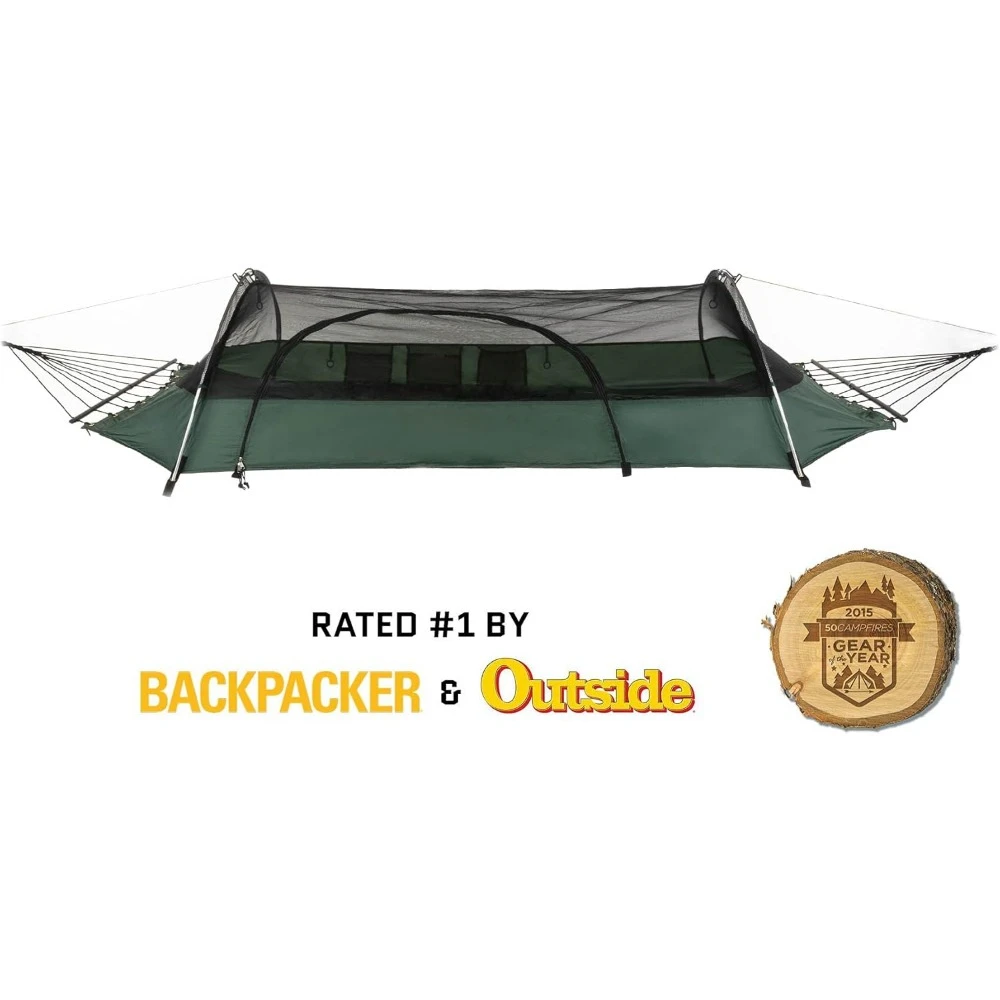
Weight Comparisons of Popular Camping Hammock Brands
To help you make an informed decision, here’s how various popular hammock options compare across weight categories:
Premium Ultralight Options
| Brand/Model | Hammock Body Weight | Suspension Weight | Max Capacity | Notable Features |
|---|---|---|---|---|
| Hummingbird Single | 5.2 oz (147 g) | 2.4 oz (68 g) | 300 lbs (136 kg) | Button-link suspension |
| Sea to Summit Ultralight | 6.3 oz (179 g) | 3.2 oz (91 g) | 300 lbs (136 kg) | Integrated compression sack |
| Warbonnet Blackbird UL | 15 oz (425 g) | 3 oz (85 g) | 275 lbs (125 kg) | Asymmetric design, integrated bug net |
Mid-Range All-Purpose Hammocks
| Brand/Model | Hammock Body Weight | Suspension Weight | Max Capacity | Notable Features |
|---|---|---|---|---|
| ENO SingleNest | 16 oz (454 g) | 11 oz (312 g) with Atlas straps | 400 lbs (181 kg) | Durable 70D nylon |
| Kammok Roo Single | 13 oz (369 g) | 9 oz (255 g) with Python straps | 400 lbs (181 kg) | Diamond ripstop fabric |
| Grand Trunk Skeeter Beeter | 28 oz (794 g) | 10 oz (283 g) | 400 lbs (181 kg) | Integrated bug net |
Budget-Friendly Options
| Brand/Model | Hammock Body Weight | Suspension Weight | Max Capacity | Notable Features |
|---|---|---|---|---|
| Wise Owl Outfitters Single | 16 oz (454 g) | 9 oz (255 g) | 400 lbs (181 kg) | Includes tree straps |
| Gold Armour XL | 17 oz (482 g) | 12 oz (340 g) | 500 lbs (227 kg) | 10-foot straps included |
| Winner Outfitters Double | 18 oz (510 g) | 10 oz (283 g) | 500 lbs (227 kg) | Budget double option |
Specialized Bridge Hammocks
| Brand/Model | Total System Weight | Max Capacity | Notable Features |
|---|---|---|---|
| Warbonnet Ridgerunner | 33 oz (936 g) | 275 lbs (125 kg) | Flat lay design |
| Lawson Blue Ridge | 42 oz (1190 g) | 275 lbs (125 kg) | Can convert to tent |
| Bridge Hammock Style | 38 oz (1077 g) | 350 lbs (159 kg) | Spreader bar system |
Complete Hammock Systems (with integrated protection)
| Brand/Model | Total System Weight | Max Capacity | Included Components |
|---|---|---|---|
| Hennessy Expedition | 42 oz (1190 g) | 250 lbs (113 kg) | Hammock, rainfly, bug net, suspension |
| Clark NX-270 | 56 oz (1587 g) | 300 lbs (136 kg) | Hammock, rainfly, bug net, storage pockets |
| Kammok Mantis | 35 oz (992 g) | 300 lbs (136 kg) | All-in-one ultralight system |
Weight-to-price analysis reveals that mid-tier hammocks often provide the best balance, while ultralight options command premium prices for specialized materials. Budget options typically add 20-30% more weight than their premium counterparts while costing significantly less.
Outside Luxe offers several options that balance weight considerations with premium construction and careful material selection, ensuring you get the perfect balance of portability and comfort for your outdoor adventures.

